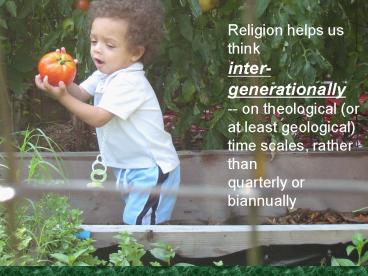Eco-Theology in America - PowerPoint PPT Presentation
1 / 15
Title: Eco-Theology in America
1
Religion helps us think inter-generationally --
on theological (or at least geological) time
scales, rather than quarterly or biannually
2
Adat Shaloms Mishnah Garden Organic
Local Educational Spiritual Communal
Activist
3
Intergenerational, Too!
4
Donated to nearby low-income fresh food desert
tikkun olam
5
- Connection
- Awareness
- Pride Joy
- Knowledge
- Experience
- Security
- Earthiness
- Cluefulness
- Tradition
6
Horseradish for Passover! Its the Real
Thing
7
And back to physical plant, where weve happily
been leapfrogged
- dont just build a building build a just
building - -- Judith Helfand
8
Jewish Reconstructionist Cong., Evanston IL
9
JRC LEED Platinum Building
!!!And awesome enviro policy, too, for what
happens there
10
First Platinum House of Worship Anywhere
-- Ever !!!
11
www.jrc-evanston.org
12
www.jrc-evanston.org
13
jrc-evanston.org COEJL.org InterfaithPowerAndLi
ght.org
14
Adat Shalom Reconstructionist Congregation
Bethesda, MD Green Building Process,
1997-2001http//www.adatshalom.net/
- Adat Shalom Reconstructionist Congregation is the
second synagogue in the US to receive the EPA
Energy Star Congregation award. A minimal
description is under "Lech Lecha" at its website,
www.jrf.org/adatsmd this might give you ideas.
The Center for a New American Dream also briefly
featured it in a video, More Fun, Less Stuff
(www.newdream.org). In short, to get others
thinking about how the Adat Shalom experience
could prove instructive, a few of its major
environmental "victories" were passive solar
heating through clerestory windows and dark floor
in social hall ner tamid (eternal light)
hooked up to a photovoltaic (solar energy) cell
on the roof a designated percentage of wood
came from certified sustainable forestry
operations good zone-by-zone heating and
lighting system implemented, with many settings
options CFL's, LED exit signs, and other
low-energy fixtures installed throughout the
building much material from the existing
building saved or kept in place for new
construction mostly local materials were used
limited Jerusalem stone shipped from Israel for
symbolism maximum number of trees on-site
before construction saved by careful planning
low-water use (xeriscaping), low-maintenance,
low-chemical, native landscaping low-impact
cork flooring used in lobby areas recycled
carpet used in sanctuary offices
mostly-recycled-or-limestone composite "vinyl
alternative" tile flooring in social hall
classrooms permeable driveway and parking lot
for groundwater recharge (gravel, then
alternative paving) wide buy-in sought from
congregation on environment as key priority
during building processAdat Shaloms Rabbi Fred
Scherlinder Dobb adds We did well! It wasn't
all rosy, however we "lost" on a few issues
theres less certified wood than we'd have liked
the design prioritized natural light over denser
construction, making it less energy efficient
linoleum would've been better than the composite
flooring we ended up with, which still contained
12 new vinyl (which is awful stuff -- to know
more about it, see Jewish activist filmmaker
Judith Helfand and her award-winning documentary
Blue Vinyl) and so on. Still, our experience
shows that with some thought and dedication, you
can do OK on a limited budget...
15
http//www.adatshalom.net/ Adat Shalom Green
Building Lessons Learned
- 1. Start early. Make environmental
issues and energy conservation clear priorities
from the get-go of the design and fund-raising
processes. Make the community aware that these
are not just choices, they are moral and
spiritual imperatives as a house devoted to God,
we must zealously strive to minimize the ways in
which its construction and operation might
adversely impact God's creation and God's
children. 2. Be ready to engage and
educate everyone involved -- from congregants to
contractors -- on environmental and energy
issues. Plan to do the legwork required to
research options, in which case you neednt be
put off by dismissive messages from an architect
or contractor. Get ready to pitch
slightly-more-expensive-but-far-more-sustainable
design elements to the board or congregation or
funders. Know how much work it will be, and know
how sacred that work is. 3. Keep
sustainability in mind throughout the process.
Use the theme of sustainability to remind people
of the ethical and religious commitments for
which we stand use it to goad donors into giving
more (and feeling good about doing so!) use it
as a rallying point for efforts to fund and build
your communal home. 4. Get information
from wherever you can, as early as you can.
Learn about your architects, general contractors
and sub-contractors' environmental awareness
before hiring them. And then plan to work
closely with them along the way, both to support
and to monitor. Unfortunately "green building"
is still new, and we have the chance to educate
the professionals about it if we take our
responsibilities seriously. Simply asking the
questions raises consciousness. 5. Know
that unless you have infinite resources, it won't
all get done at once. Do the best you can with
what's available, and keep a 'wish list' in mind
for future expansions or retrofits. Don't
despair because you can't have every
energy-saving device or construction technique
since you can't do everything, it's still better
to do what you can. Know that every CFL, every
LED exit sign, every double-glazed window, every
square foot of recycled carpet, every
programmable thermostat makes a difference, and
is sacred. As Rabbi Tarfon wrote almost 2000
years ago in the Mishnah (Avot 221), "it is not
upon you to complete the task -- but neither are
you free to desist from it."































